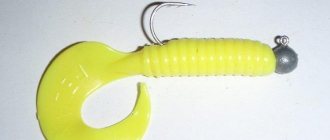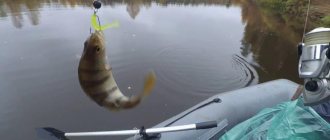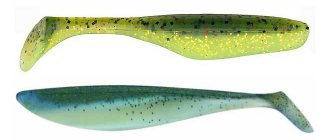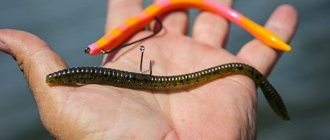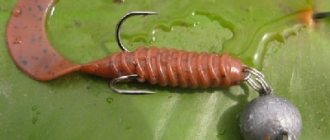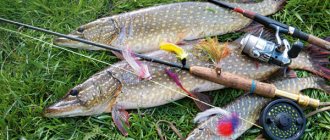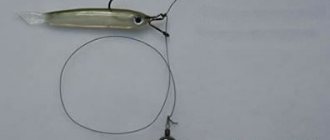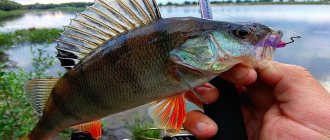Twister is an artificial fishing bait made of silicone and used in spinning fishing. The twister consists of a cylindrical body, most often ribbed, and a crescent-shaped elastic tail. The dimensions of the twister can range from 1 to 30 cm. Perch, pike, pike perch and many other types of predatory and even peaceful fish are caught with the twister. When fishing with a spinning rod, the twister is mounted on a jig head or on an offset hook with an eared weight attached to it.
In our publication we will talk about the history of the twister, its sizes and colors, advantages and disadvantages, methods of installing the twister, and give a rating of the 10 best twisters.
What is a twister?
A twister is a silicone bait consisting of a cylindrical body, most often ribbed, and a crescent-shaped elastic tail.
The name “twister” has stuck since the very first silicone baits, produced by the Mister Twister company, appeared on the market in the 70s of the 20th century.
The twister body can be either thin or voluminous. The length of the twister body can also vary: from very short to long. The body of the twister can be strongly ribbed, weakly ribbed, or have no ribbing at all. The ribbing of the twister body is designed to create additional acoustic noise that attracts a predator.
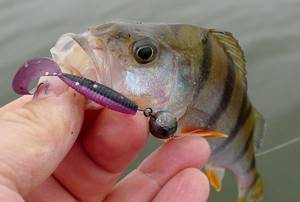
The elastic tail of the twister is the main element that attracts fish when retrieving the bait. When retrieving, the soft ribbon tail makes specific movements in the water that attract fish from a great distance and cause an aggressive reaction in it in the form of a desire to attack the twister like a real food object. Twister tails differ in length, thickness and degree of curvature. When the shape and size of the twister's tail changes, its play changes. If the game of the purchased twister does not satisfy the angler, then he can improve it by trimming his tail a little.
Twister, along with vibrotail, is the main type of silicone bait. Twister is a silicone bait that has its own active game when retrieving.
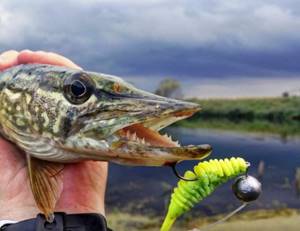
The twister can be made from either regular silicone or edible silicone. Edible silicone is the name given to baits in the production of which amino acids, flavored salts, and various attractants are added to the silicone. Edible rubber attracts fish not only with its appearance, but also with its smell and taste.
What is the difference between a twister and a vibrotail
Twisters and vibrotails are two of the most popular types of silicone baits. There are both similarities and differences between these two types of baits.
Both types of baits can be made from edible or regular silicone. The vibrotail has a body shape in the form of a small fish, protruding, slightly flattened on the sides, with a noticeable narrowing towards the tail; in the twister, the body has a cylindrical shape, with a grooved or smooth surface. The twister's tail has the shape of a sickle-shaped, elastic band; the vibrotail's tail has the shape of a hoof, located perpendicular to the axis of the body.
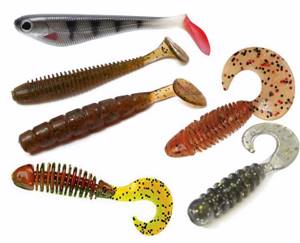
The twister has a higher frequency play, the vibrating tail plays with a lower frequency, but with a larger amplitude.
When fishing for pike and pike-perch, spinners often use vibrating tails, and when fishing for perch, twisters are more often used.
Twisters have better flight characteristics than vibrotails, so they are more convenient when fishing from the shore, in cases where longer casting is required.
Twisters mounted in the form of non-hooking rods are well suited for fishing in places with snags and strong underwater vegetation.
Twister size
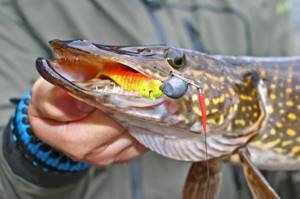
Twisters come in a variety of sizes from the smallest to the largest. By size, twisters can be divided into 3 groups:
- 1-2 inches (2.5-5 cm) – used in microjig and nanojig, used for catching perch, sometimes peaceful fish can be caught on them
- 2.5-4 inches (6.3-10.1 cm) - baits for light and medium jigs, the most common group of twisters, used for catching pike, pike perch, large perch
- More than 4 inches (10.1 cm) - used for heavy jigging and trolling, used for catching large pike and catfish
An angler should have twisters of various sizes in his arsenal.
Twister colors
Twisters are available in a wide variety of shades and colors. The choice of bait color depends on the time of year, temperature, light and water transparency.
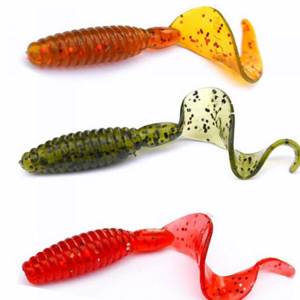
In muddy water after spring floods or previous rains, twisters of bright and acidic colors, as well as interspersed with sparkles and a fluorescent effect, show good results.
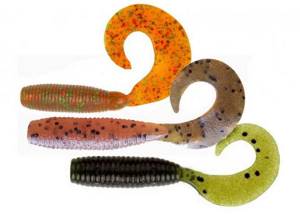
In clear water, fish respond better to calmer and more natural tones. On cloudy days, twisters of light colors are more visible in the water: white, silver, golden and yellow.
On sunny days, twisters of orange, golden, chestnut and green colors work well.
In clear sunny weather, twisters of dark colors give good results: black, blue, purple and brown, corresponding to larvae, crustaceans and insects living near water bodies.
When fishing with a twister at great depths, you should use acidic colors of light green and yellow.
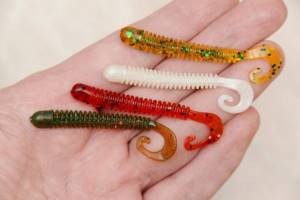
When fishing with a spinning rod in open water in winter, you can try fishing with twisters of blue and purple shades.
Pike perch prefers baits of yellow and yellow-green colors. Perch often prefers red baits. Pike can be caught using twisters of a wide variety of colors.
Twister bait: the subtleties of fishing for perch and pike
It’s hard to imagine modern fishing without the use of twisters – universal baits for various bodies of water. With their help, you can try to successfully catch pike, asp, chub, perch, pike perch, burbot, rudd, grayling, trout, and catfish. Regardless of the depth of the reservoir, illumination, bottom topography and current strength, such baits bring rich harvests.
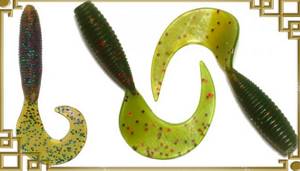
What is a twister?
Among fishing enthusiasts, this name refers to a huge selection of baits made of silicone. They have a cylindrical elongated shape with a flat crescent-shaped tail at the end. In stores you can purchase modifications of twisters that have their own play during wiring. Several years ago, manufacturers of such baits used ordinary silicone material for production. Its use provided the products with high levels of elasticity and plasticity, which is why in the water element the baits sat securely on the hooks and behaved quickly, imitating the behavior of small fish. Predators attacked them, reacting exclusively to movements, but were not always detected.
Today, edible soft rubber has come to the fore in the production of artificial baits. Its creators add amino acids, flavored salts, and various attractants to silicone. Thus, baits appear that not only actively move, but also smell attractive, without raising doubts among predators.
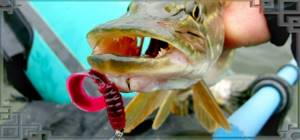
“Edible” also has its own drawback - unreliable strength. It doesn't last long and quickly deteriorates. To bring it out of working condition, even the grip of a perch and asp, which do not have toothy mouths, is enough. On the other hand, such baits are much more catchy, which makes up for their disadvantage, besides, silicone is a consumable material, and nothing can be done about it.
Beginner fishermen confuse twisters with vibrotails. Both baits are made from silicone, but the second shape is more like a small fish. The main difference between a vibrotail and a twister is a more mobile tail. Thanks to this design, it plays better when wired.
What to choose, a twister or a vibrotail, each angler decides for himself. For pike hunting, the best option would be the second one; in water it is characterized by vibrations with low frequency and wide amplitude. Toothfish like such bait games more, since twisters create high-frequency vibrations.
They are also given an advantage in cases where long and targeted casts must be made from the shore. Their flight properties are much better than those of vibrotails. But if the fishing spots are covered with vegetation or snags, then it is advisable to choose a twister with a bait that catches less. In any case, every spinner should have new twisters and vibrotails that have been in “battles”.
Technologies and methods of twister installation
There are several successful ways to attach such a bait to create catchy fishing gear. The most popular are:
- installation based on a jig head;
- spaced twister rigs;
- non-snacking lure mounts;
- hinged mounting method.
The technique of spaced rigs is that the weight and the bait must be moved away from each other. In this case, the silicone gets more free space and allows the person with the rod to perform measured, slow retrieves.
When fishing in more difficult conditions, you need to choose equipment that does not get caught on obstacles. With this type of installation, you can confidently fish rocky areas of the bottom, snags, and reservoirs with abundant vegetation. It is better to attach the nozzle in tandem with an offset hook, then it can easily pass through difficult places. With such equipment, the tip is hidden in silicone, and with a successful bite it is released and dug into the predator’s mouth.
To properly attach a twister attachment to an offset hook, you need to select an offset of the required length. Then pierce the bait through the “mouth” from the head and bring the tip out into the “neck” area. The twister is pulled to the bend and smoothly brought to the eye. Having unrolled the hook, carefully fold the body of the bait and sharply pierce it. The sting is brought out at the top of the nozzle and “sunk” in silicone. At the last stage, the bait with a sharp offset hook is attached to a sinker of the required weight.
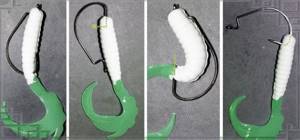
The most popular (even beginners and novice spinning anglers can handle it) way of mounting twisters is to mount them on a jig head - the bait is placed on a hook rigidly fixed in a weight. Twister jig heads come in the shape of a bullet, horseshoe, fish head, and boot. The most common are spherical. Such equipment is not difficult and provides the structure with the necessary rigidity of the connection.
The technology of hinged combination is that the twister is adapted to a single (you can use a double, triple - as you like) hook and attached to a weight called a “Cheburashka”. This fastening gives the bait a high level of freedom, allowing you to cast it to a maximum distance. The twister is attached to the weight with a clasp or winding ring. The disadvantage of this method is the possible overlap through the leash. In this case, the wiring will be less effective. To avoid unnecessary misfire, before inserting the twister, you need to slow down the slippery line by touching the spool with your fingers.
Predator color preferences
The choice of bait color depends on the time of year, temperature, light and the state of the water, which becomes cloudy in the spring, so predators prefer bright baits. But when everyone who wants to return with a trophy catch installs twisters of the same colors, the objects of hunting will simply stop reacting to them.
In winter, if the reservoir is not frozen, sluggish predators can be attracted by blue and purple tones. Pike-perch prefer baits of yellow and yellow-green shades. Black baits imitate a leech, and cod and perch can be tempted by them (sometimes they like brown colors).
On sunny days, twisters in orange, golden, chestnut and green shades work well. When the sky is covered with clouds or the fish is being fished at great depths, it is advisable to use colorful baits for a good harvest. When partly cloudy, red colors are used. If black and silver glitter (similar in color to the natural food of predators) on silicone does not bring the desired result, you can switch to green and red. It is important to remember that bites with a properly selected bait occur on every retrieve. And the “unloved” color on this day may not have them at all.
As for the smell of silicone, predators like the aromas of bloodworms, maggots, sea shrimp, worms, animal blood and fish.
Catching perch with a twister
Attempts to catch nimble striped bass with this type of bait bring real pleasure to many. But in order not to leave the reservoir without a catch, you need to know a few tricks for catching them. When rigging, it is better to use silicone substitutes for live fish of the smallest size (no more than 5 cm in length, although large individuals can also be lured with pike baits). The easiest way to choose the color scheme and size of the twister is directly on the pond, since the perch is quite picky.
Advantages and disadvantages of twister
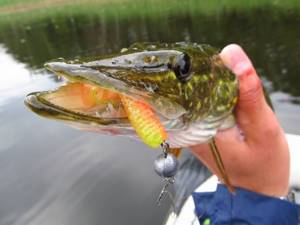
Like any other spinning bait, the twister has its advantages and disadvantages.
The advantages of a twister include:
- Low cost
- Various installation options
- A wide variety of twisters in appearance, color, size, material
The disadvantages of twister include:
- Damage to the twister when grabbed by a predator or caught on snags or stones
Twister installation methods
There are several ways to install a twister, each of which has its own pros and cons.
Installing a twister on a jig head
Attaching a twister to a jig head is the most common way to mount this silicone bait. The most universal mounting method, can be used in a wide variety of fishing conditions. The jig head is a hook with a weight rigidly attached to it. The jig head can be in the shape of a bullet, fish head or boot, but the most common shape is a ball.
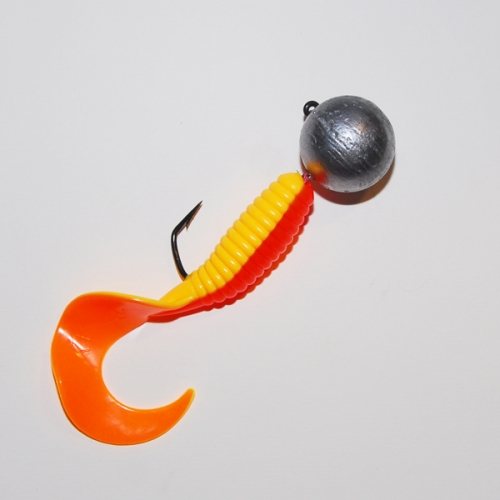
In order to attach a twister to the hook of a jig head, you must first compare their sizes with each other by attaching the hook to the body of the twister. The tip of the hook should come out on the last ribs of the twister, then it will work as it should.
Having remembered the place on the twister where the tip of the hook should come out, stick the hook into the end of the twister, carefully put the twister on it and bring it out in the place of the twister that you outlined at the very beginning. The hook, after installation, should not touch the tail of the twister.
You may be interested in: Spoons for pike
Hinged mounting of a twister on an offset hook with a Cheburashka weight
Hinged mounting of a twister on a hook with a Cheburashka weight is one of the best ways to mount this bait. This mounting method gives the bait a maximum degree of freedom, which increases the chances of the bait being attacked by a predator. In addition, this installation method ensures maximum casting range.

With a hinged installation, the twister can be mounted on a single, double or even triple hook. The hook is attached to the Cheburashka weight, either through a clasp that can be removed from it, or if the weight is not removable, then through a winding ring.
In order to place a twister on a hook, you first need to select a hook of the required length by attaching the twister to it and checking that the sizes match each other.
Insert the tip of the hook into the end of the twister, pass it through the body of the twister, and remove it from the body in a pre-designated place. After this, attach the hook to the weight.
When attaching a hook to a regular non-separable Cheburashka, you should either use two winding rings connected in series, or rotate the eye of the Cheburashka 90 degrees.
Installation of a twister on an offset hook in the form of a non-hook
Fishing with twisters is often carried out in difficult places: in areas with a rocky bottom, in snags, in reservoirs heavily overgrown with underwater vegetation. In such places, in order to avoid a large number of hooks and bait breaks, you should fish with a twister on an offset hook mounted in the form of a non-hooking hook. With this installation option, the tip of the hook is pressed to the body of the twister, and when a predator bites, it is released and digs into its mouth.
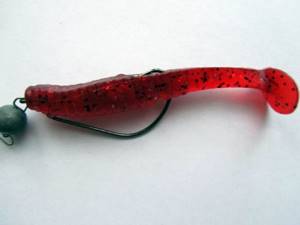
In order to mount the twister on an offset hook in the form of a non-hook, we pierce the end of the twister with the tip of the hook, insert it inside and bend it at a right angle. We stretch the twister to the shank of the hook. We try the twister on the hook and remember the location of the future puncture. We pierce the twister perpendicular to his body. We check the quality of installation of the twister, to do this we run our finger along its body; the finger should not cling to the hook, and with light pressure the body of the twister should sag.
Hinged mounting of a twister on a double with a Cheburashka load
Quite often, the twister is mounted on a double hook with a Cheburashka weight attached to it. There are two ways to mount a twister on a double. The simplest option is when the double is slightly spread apart, a twister is placed on one hook in the usual way, as on a single hook, and the other hook of the double is located outside the twister and acts as a pressure spring. This installation option is simple and allows you to quickly replace the twister on a double if necessary.
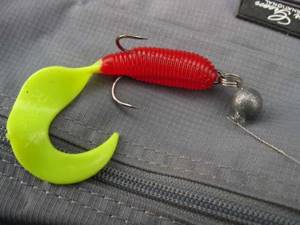
Another option for installing a twister is more complex. The hooks of the double are slightly moved apart, the tip of one hook pierces the twister approximately in the middle of the body of the twister, then the twister is pulled along the fore-end, to the eye of the double. When the eye of the double is in the body of the twister, push it forward of the body of the twister until the eye comes out at the end of the twister. With this installation method, you should use a twister made of durable and elastic silicone, otherwise the twister will break during installation.
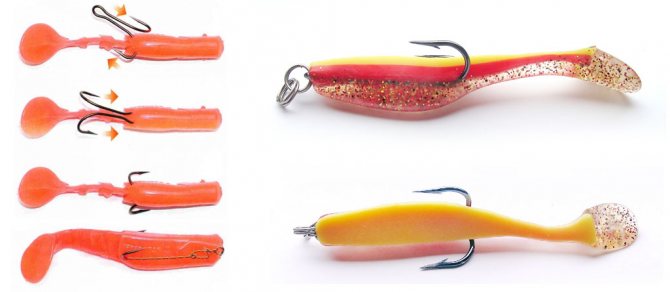
Exploded snap-ins

Recently, a wide variety of spaced-out equipment has become increasingly popular among spinning fishermen. With spaced rigs, the silicone bait attached to the hook and weight are spaced apart from each other. With this installation option, the silicone bait receives more freedom of movement, and the angler can perform a wide variety of wiring. Spaced spinning rigs include: lead leader, drop shot, split shot, Texas and Carolina rigs. With all these and other spaced-apart equipment, you can and should use a twister.
Mounting options
The method of setting the bait depends on the type of predator and the fishing method. From the many existing classical and narrowly targeted installation options, 3 popular techniques can be distinguished.
On a jig head
This is the oldest method and the basic one. It is recommended for inexperienced anglers to start with it. The hook of the jig head is rigidly fixed in the lead sinker, onto which the twister is put. The head and bait must match in size. There are many options for heads in the shape of a horseshoe, ball, fish head, etc.
The advantages of the technique are:
- simple installation;
- connection rigidity;
- stable operation and good hooking.
The method has disadvantages, such as insufficient casting range due to drag, impossibility of installation on strong places due to the open hook, low speed when moving to the bottom. There is one more nuance: it is easier for the fish to free themselves from the hook due to the rigid connection.
Articulated
This technique of equipping a jig head (free mounting of a twister) provides a casting range, and the bait has greater freedom. With the hinge method, the twister is attached to a hook (single, double or triple), then attached to the sinker using a clasp or ring. A collapsible sinker is more mobile and convenient; its use eliminates unnecessary parts in the equipment.
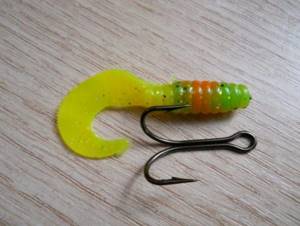
The method has a disadvantage when using open hooks. The twister may overlap the leash, which will mean idle wiring. This can be avoided if, before splashing down the bait, you slow down the line a little by touching the spool with your finger.
Unhooked
In difficult fishing conditions, non-hooking jig heads are used. The technique is useful when fishing in snags, aquatic vegetation, and rocky areas. The main condition is to equip the twister with an offset hook.
Read: Installation of offset hook
The bait mount looks like this:
- it is necessary to select an offset of the appropriate length;
- the bait is pierced from the head, and the hook is brought out through the “neck”;
- the twister is pulled to the offset bend and brought to the eye;
- the hook unfolds, the slightly curved body of the bait is pierced;
- the tip is brought out at the top of the twister; if necessary, it is recessed into it;
- the offset bait is attached to the sinker.
The hook sting is hidden in the body of the bait, which allows it to overcome difficult areas. At the moment of the bite, the hook is released and cuts through the mouth of the predator.
Selection, storage and repair of twisters
When choosing a twister, the fisherman should take into account the properties of the silicone from which the twister is made. The body of the twister can be made of hard silicone, but the tail of the twister must be thin, soft and elastic. The soft tail creates an active game with high-frequency oscillations, and the more tightly the tail spiral is twisted, the more active and sweeping the twister will play during the retrieve.
When buying twisters, immediately take a package of twisters of the same model, color and size, then during fishing, if you lose a catchy bait, you can quickly replace it with the same one.
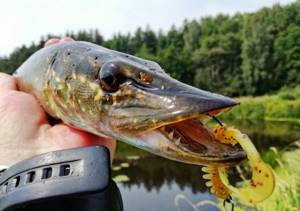
Store twisters either in their original original packaging or in separate compartments of the bait storage box. Twisters of different colors should not touch each other so that they do not stick together and stain one bait with another.
While fishing, you can quickly change the color of the twister by painting it in whole or in part with a waterproof marker.
A twister damaged by the teeth of a predator can be easily repaired; to do this, heat the rupture site over the flame of a lighter, connect the rupture site and fix it for 10-15 seconds.
To enhance the aroma of twisters, you can apply a few drops of attractant to the body and tail of the twister.
When installing the twister, try to ensure that the hook runs strictly along the axis of the twister’s body; this will protect the twister from falling over during wiring and the hook catching on the bottom when tossing.
Rating of the 10 best twisters
Among the many models of twisters presented in fishing stores, there are those that have long been tested by fishermen and have proven themselves to be excellent.
Twister Reins Fat G-Tail Grub

The body of the twister is solid, round in cross-section, with shallow perforations, reminiscent of a worm or larva. In the middle of the body of the twister there is a thickening in the center for easy installation on the hook. The silicone from which the bait is made has an increased density to increase the service life of the bait on the hook. The silicone contains added salt and an attractant that is resistant to leaching and weathering. The Reins Fat G Tail Grub comes in three lengths of two (5 cm), three (7.5 cm) and four inches (10 cm). A two-inch twister is good for catching bass of any size. The twister is three inches long and is the most versatile, suitable for catching perch, pike and pike perch. A four-inch twister should be used for catching large walleye and pike. There are more than two dozen twister color options. The Reins Fat G-Tail Grub twister is especially effective on even retrieving with playing along. You may be interested in: Microjig
Twister Relax Twister
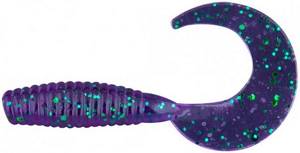
The Relax Twister has a classic twister appearance, with a ribbed body and a flat crescent-shaped tail. The Relax Twister has an active game and is made of strong and durable silicone. Twister has a wide range of sizes and a large number of colors. The Relax Twister is well suited for catching pike and zander on the river.
Twister Keitech Mad Wag
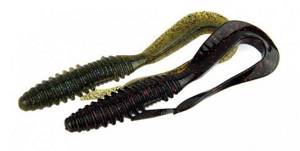
The Keitech Mad Wag twister is an excellent silicone bait designed for catching large pike, pike perch and catfish. The twister is 7 inches long, has a powerful ribbed body and a long triangular tail. The special tail design allows the bait to play even on the slowest retrieve. The ribs on the body of the twister not only visually increase the size of the bait, but also, when used with an offset hook, make the bait almost completely hook-free. The Keitech Mad Wag twister creates very powerful vibrations in the water that attract predators from a great distance. The twister is made of soft edible silicone, which contains a squid attractant. The twister can be mounted on a jig head, on an offset hook with a Cheburashka weight, and the twister can also be used as part of a variety of spaced rigs. The Keitech Mad Wag twister is produced in more than a dozen different colors, mostly dark shades.
Twister Mann`s Twister
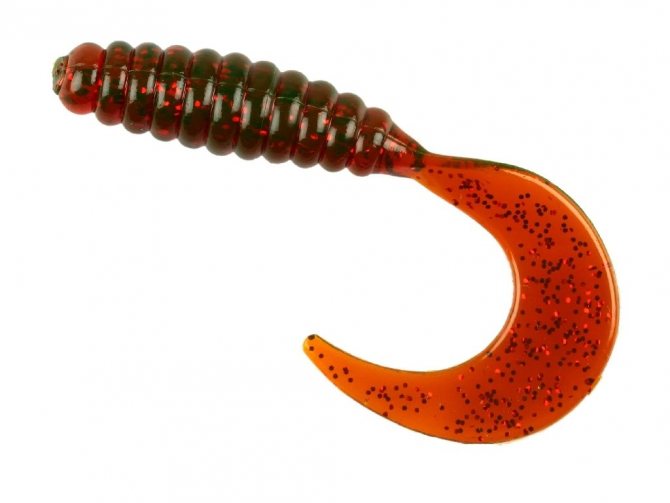
Mann's Twister has a classic twister shape: a ribbed body and a crescent-shaped ribbon tail. The bait is made of inedible silicone; the material retains its properties at low temperatures and is quite resistant to damage from the teeth of predators. Mann's Twister has an extremely mobile tail, which surprisingly resembles the movements of small fish. The bait is available in a variety of colors.
Twister Lucky John Pro Series Ballist
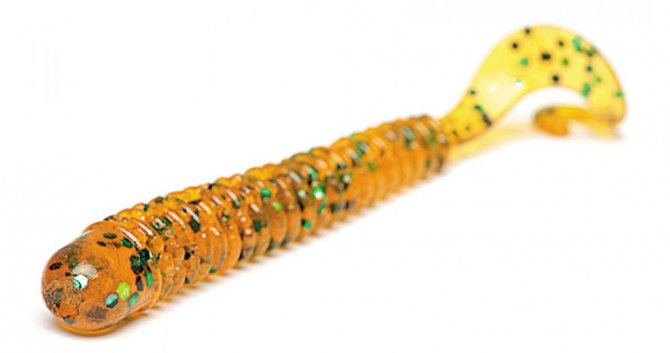
The Lucky John Pro Series Ballist twister is a hybrid between a twister and a silicone worm. The bait has an elongated ribbed worm-like body and a twister tail; its appearance can imitate different food items: fry, leech or worm. The Lucky John Pro Series Ballist twister is made of edible silicone with the addition of a shrimp-flavored attractant and comes in many color options. The twister can be used to catch pike perch, pike perch and pike perch.
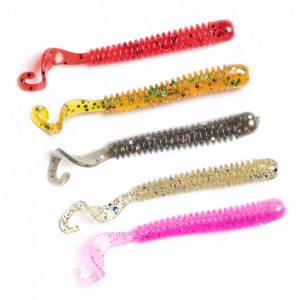
The Lucky John Pro Series Ballist twister can be used with classic mounting options: on a jig head or on an eared weight, as well as for a split shot, lead leader, Texas and Carolina rigs. When fishing with the Lucky John Pro Series Ballist twister, you should use a slow, bottom retrieve, with light loading. You can diversify the fishing by dragging the bait along the bottom, taking short breaks of 10-15 seconds. Good results are shown by short stepwise wiring of one revolution of the coil, with pauses of 2-3 seconds.
Twister Pontoon 21 Hightailer
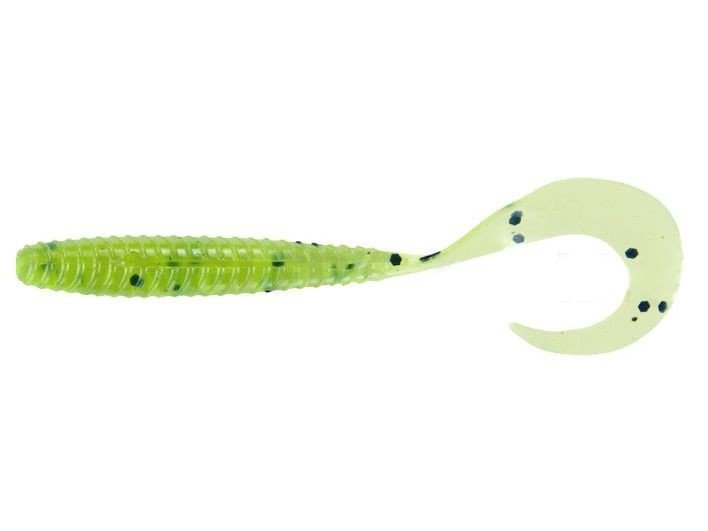
The Pontoon 21 Hightailer twister is made of soft edible silicone of the GUMEXIM brand with the addition of the SFT attractant. The twister has an elongated, slightly ribbed body and a long crescent-shaped tail. Inside the body of the Pontoon 21 Hightailer twister there is a special longitudinal channel, which makes it easier and more accurate to mount the twister on the hook, maintaining the correct centering and avoiding the bait falling over when retrieving. The size range includes twisters in 5 sizes, from 2 to 3.25 inches. The bait can be used when fishing both in still water and in the current; it plays well even on the slowest retrieve. The attractants included in the silicone twister additionally add to its attractiveness in the eyes of predators.
Twister Relax Turbo
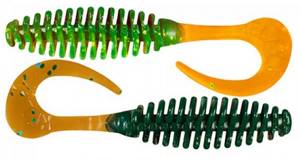
The Relax Turbo twister is produced by the American company Relax, well known to anglers. The twister is made of high-quality elastic silicone, which provides the bait with realistic movement at any fishing speed. The Relax Turbo twister is made using multi-level lamination technology, thanks to which different color layers are combined in the bait.
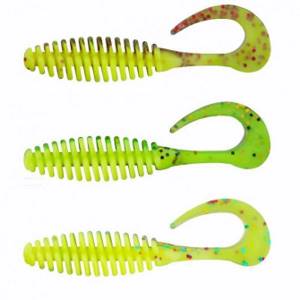
The Relax Turbo twister has positive buoyancy, which expands the fishing possibilities and provides a more interesting play of the bait when retrieving. Twister is produced in a wide range of colors.
Twister Crazy Fish Angry Spin
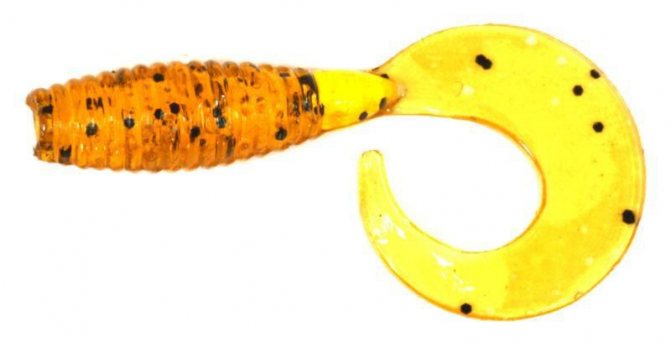
Twister Crazy Fish Angry Spin is a universal twister suitable for catching a wide variety of fish. The twister is made of soft silicone with the addition of two attractants and salt granules, which are embedded in the silicone, thanks to which the twister retains the aroma that attracts fish even after prolonged use. The tail of the Crazy Fish Angry Spin twister is very soft and flexible even with the slowest retrieve. The 1-inch long Crazy Fish Angry Spin is suitable for catching perch in tight ponds and can also be used for catching bream, rudd and other peaceful fish.
A twister so small that it can maintain its game even on a jig weighing 0.3 grams. The 2-inch long Crazy Fish Angry Spin twister is good for catching good perch, zander and medium-sized pike. Twister is available in a large number of catchy colors.
Twister YUM Walleye Grub
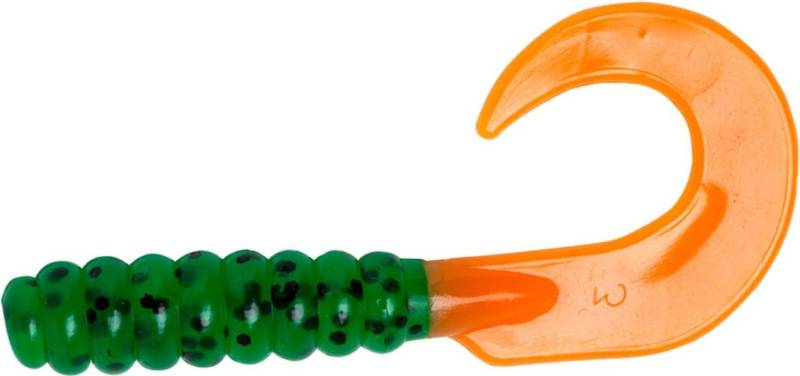
YUM Walleye Grub is a classic twister made from soft edible silicone with a strong and lasting anise aroma. The body of the YUM Walleye Grub twister has a heavily ribbed surface and a classic crescent-shaped tail. The twister tail plays well even with the slowest wiring. The bait is well suited for fishing in still water and on rivers. Twister is available in more than 20 color options. The twister can be used both in classic mounting options and for drop-shot and pull-out leash.

Twister Action Plastics 3FG
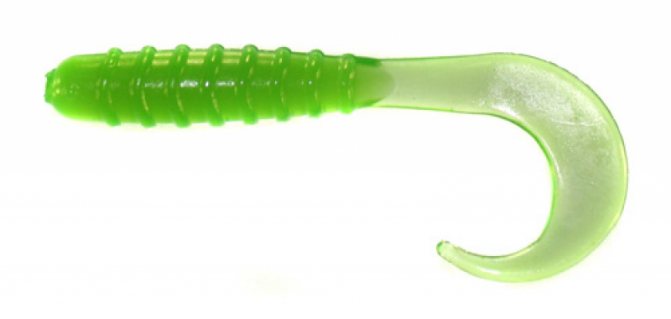
The Action Plastics 3FG twister is a classic twister with a ribbed body and a standard crescent tail. The silicone from which the twister is made is quite wear-resistant and can withstand several pike bites. Works well for most predators: perch, bass, pike and pike perch. The twister is produced in a variety of color variations, among which every angler will be able to choose the most suitable bait for specific fishing conditions. Twister has a good price-quality ratio. The Action Plastics 3FG twister can be used both in classic mounting options and for drop-shot and lead leash.
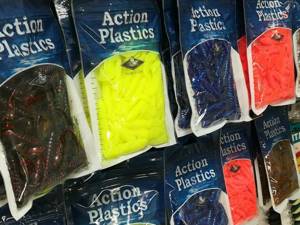
The most famous twisters
Today there are a huge number of companies producing silicone baits. But there are not so many of those who own original developments and whose products have been tested by time. Here is a list of the most popular brands:
- Mann's.
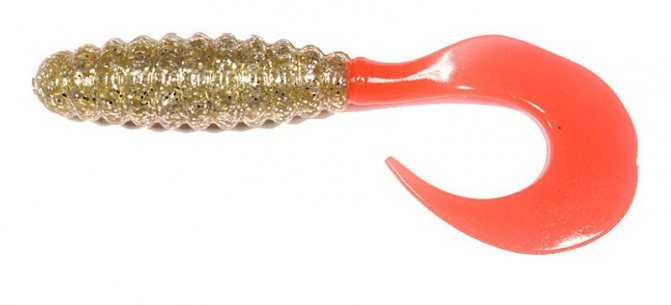
An American company that began its activities in the 50s of the last century. The main twister models are as follows:
- Manipulator. Twisters made of soft silicone with a movable tail and dents in it.
Lucky. Twisters with a fairly short tail and with or without holes in it.
- Nika. There is a characteristic “heel” on the tail of the twister.
- Ajax. Large size twisters.
- Rumba. Twisters with positive buoyancy. There are slots on the sides of the body for the double.
- Relax.

A Polish company that moved its production to China. Twisters Relax have a good price/quality ratio. They are made of fairly dense silicone, which significantly extends their service life. Widest choice of colors. The most famous models are:
- Twister. A model with a sonorous name that speaks for itself.
Select. A simple twister without any bells and whistles, but very catchy.
- Turbo. Twister with powerful ribs on the body.
- DTT. Twister with double tail.
- Action Plastics.
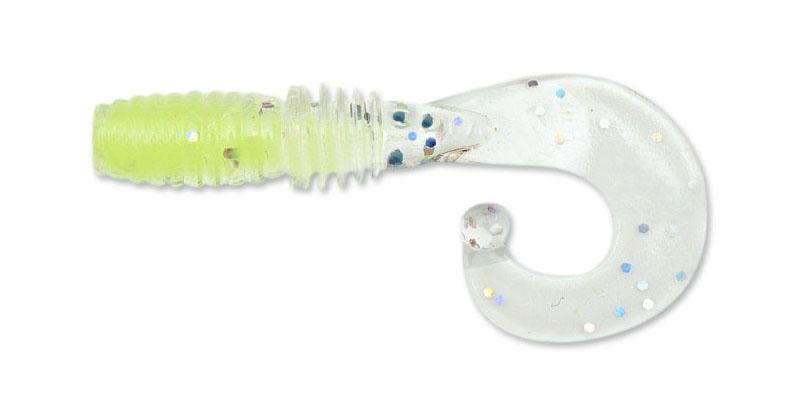
One of the most inexpensive, but at the same time real American twisters. The most popular models are:
- F.G. These twisters do not have a sonorous name; modifications are designated 3FG or 5FG, where the number indicates the length of the bait in inches.
Curl Tail Grub. Twisters with a “thick” body and a short tail.
- SLG and 2FFT are less popular models that have a standard design.
- YUM.
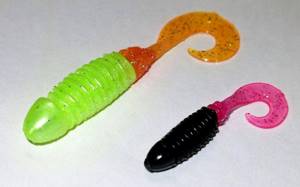
Twisters made in America. Thickly sprinkled with salt in packages. Traditional models are:
- Muy Grub;
Walley Grub;
The original models are presented:
- Wooly Curtail. Twister with a thick body, powerful radial ribs and a short tail;
- Samurai Curtail. The body of the twister is made in the shape of a fish, round in cross-section with a fin and a characteristic head, and when the body is oriented in a position familiar to a fish, the tail of the twister turns out to be bent up, not down.
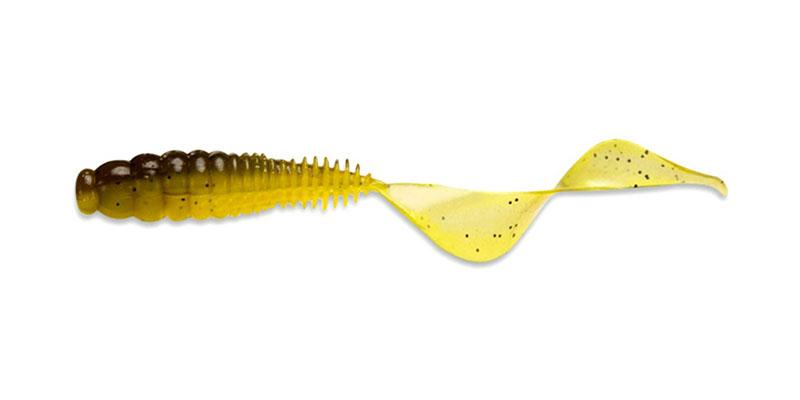
The Japanese company positions its products as “edible” rubber, although many fishermen doubt this. However, Awaruna vibrator tails have already proven their catchability. Two existing twister models are not far behind them:
- Homunculures Pillo. Twister has a very original structure. The rounded ribs on the body, starting in the head, turn into plate-like radial ribs closer to the tail. The entire structure ends with a tail curved in two planes;
Homunculures Jilt. A twister with a more traditional structure.
One hundred percent “edible” twisters are produced by the company Reins . The G-Tail Grub model has proven itself very well when catching perch with spaced rigs.
Catching perch with a twister
Perch is perfectly caught using a twister. The usual size of a twister for catching perch is 4-5 cm; larger perches can be caught with larger baits.
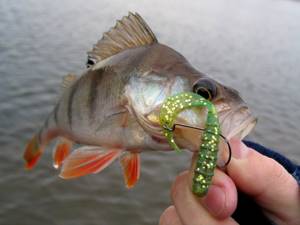
Perch is caught using twisters of various colors, so you need to select the color of the twister directly on the pond. On sunny days, yellow, golden, orange and light brown twisters work well. In cloudy weather, when fishing in muddy water and at great depths, twisters of bright, acidic colors are well suited; they are much better visible in dark water and the spectrum of their light is much less distorted than that of baits of other colors, which at depths of more than 3 meters become dimmer than in the light. The attack point in the form of either a red head on a twister or a red tail attracts perch well. Perch responds well to edible rubber with the smell of attractants and interspersed with iridescent sparkles.
You may be interested in: How to tie a leash to the main fishing line
The fisherman needs to have twisters of various types, sizes and colors in his arsenal in order to be able to experiment with the bait while fishing.
The speed at which the twister is pulled depends on the degree of activity of the perch, which in turn largely depends on the water temperature. In sunny weather and well-warmed water, the perch behaves more actively, so the twister can be played at a fast pace. In cold water, perch is much less active, so the fishing speed needs to be reduced.
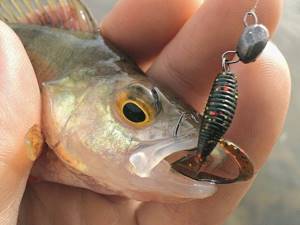
When catching perch with a twister, both uniform and stepped retrieves are used. Stepped wiring is used when fishing on the edges, on uneven bottoms, at the entrances and exits of pits. Uniform wiring is used when fishing on sandbanks, on smooth rises from the riverbed on sandy river spits, over snags, and in areas with a flat bottom.
The weight of the head or cheburashka sinker is selected depending on the fishing conditions; in still water their weight is most often from 3 to 15 grams; in strong currents, weights from 15 to 28 grams are used.
Very good results when catching perch with a twister are obtained by using spaced rigs, primarily a retractable leash and a drop shot. When catching perch on a retractable leash and a drop shot, use a 3-5 cm twister. The dregs from the weight stretching along the bottom arouses the initial interest of the perch, which comes closer to the silicone bait, and upon noticing it, attacks. When catching perch with a twister, it is possible to use equipment consisting of several twisters located at some distance from each other and running at different depth horizons. Such equipment makes it possible to quickly find active perch sites, and also makes it possible to catch several perches at once in one trip.
What is a twister
Beginning fishermen often have questions about what fishing twisters are, whether it is effective to fish with them and how to fish with them. Twister is an artificial fishing bait made of polymer material that imitates a worm, frog, loach and other living organisms. These are universal products that are used in any reservoir, under any fishing conditions for catching predatory fish. They work effectively in standing water and strong currents.
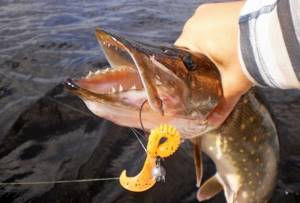
The product has a ribbed body and a curved sickle-shaped tail. When moving in the water, it makes wave-like vibrations, which attracts fish. The smallest specimens measure 1 cm, the largest ones reach 30 cm.
Catching pike with a twister
Twister is a universal bait for catching pike, which can be used for fishing both in still water and in the current, both in overgrown shallow waters and in great depths.
The size of a twister for pike fishing depends on the size of the intended prey. To catch small and medium-sized pike, twisters 2.5-3 inches long are used. Twisters measuring 4 inches or larger are used to catch trophy pike. To catch the largest pike, weighing 6-8 kg, twisters 15-20 cm long are used. In shape, pike prefer twisters with a ribbed body and a wide tail.
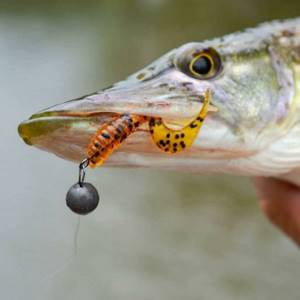
Pike can be caught on twisters of various colors and patterns. Twisters of lemon, yellow, light green, golden, white and red, and brown colors are considered the most effective for pike fishing. A pike fisherman must have in his arsenal 7-8 different models of twisters, in 3-4 colors each, in order to be able to choose a bait for specific fishing conditions.
When catching pike with a twister, all the main mounting methods are used: on a jig head, on an offset hook with a Cheburashka weight, on a “non-hooking” mounting option. Non-hooking baits are used when fishing in snags, places heavily overgrown with underwater vegetation. In clean places, double hooks should be used, which greatly increase the chances of successfully hooking a pecked predator. The size of the hook should match the size of the twister, the tip of the hook should come out of the end of the twister body, not far from the tail.
When fishing for pike, the twister quickly becomes unusable from pike attacks, so the angler should have a supply of twisters in order to be able to quickly change the bait.
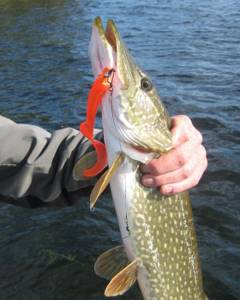
When catching pike with a twister in the spring, you should use medium and large-sized baits in soft light colors. In spring, pike fishing is carried out in well-warmed shallow waters, not far from its spawning grounds. Staggered or uniform wiring should be used. The wiring speed should be slow or medium. In areas with a clean sandy bottom, you can use slow dragging of the twister along the bottom with short jerks with the tip of the rod.
To catch pike with a twister in the summer, you should use small and medium-sized twisters of different colors. The best time to catch pike in summer is morning and evening. The best places for catching pike in the summer are thickets of aquatic vegetation, on the border of grass and clean water, and leatherfish. It is better to start fishing with lures of natural colors: silver, golden and white, and towards the middle of the day use twisters of bright colors. Casts should be made parallel to the edge of the aquatic vegetation. You should experiment with wiring: start with a slow step, then try a fast step, then a uniform wiring.
At the beginning of autumn, pike should be caught near thickets of aquatic vegetation; starting from mid-autumn, pike should be caught on deep shafts, holes, and snags. In autumn, large twisters with active play and colors close to natural should be used. In autumn, you can use stepped wiring at an average pace and uniform wiring.
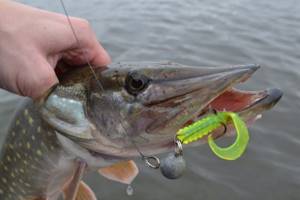
The main wiring used when fishing for pike with a twister is stepped and uniform. Uniform wiring is effective when moving the bait along the border of aquatic vegetation, as well as when fishing for pike in shallows with a flat bottom. The speed of a uniform retrieve depends on the degree of activity of the predator: an active predator attacks at a fast retrieve speed, a passive predator attacks only a slowly moving bait.
Stepped fishing is used when fishing for pike on uneven bottoms. The step is carried out by three to four turns of the coil, followed by a pause. The duration of the pause in summer should be 3-4 seconds, in autumn and spring the duration of the pause reaches 6-8 seconds, and sometimes even increases to 10-12 seconds. Most of the pike's attacks on the bait occur during a pause, when the bait freely falls to the bottom.
The optimal size of a vibrating tail for pike fishing
As for size, pike are not particularly picky about what they eat, except on hot summer days. At this time, she rarely chases prey, but is content to swim by itself. This behavior is also typical for the pre-spawning period. For such periods, it is better to use rippers no longer than 50 mm as bait.
The vibrotail for pike in the fall and spring after spawning should have a length of 70 mm. The optimal size of silicone for the time of greatest activity of this predator is considered to be 70-120 mm.
